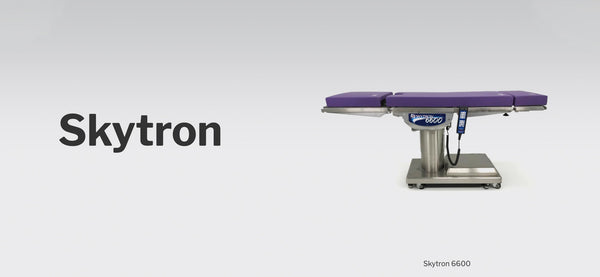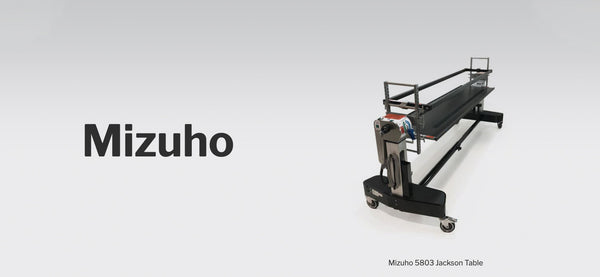
What to Know About Used Surgical Tables
The use of operating room surgical tables can be dated back to the 18th century. Doctors used "surgical chairs" and restraints to hold patients up when they would become unconscious during surgery.
Lithotomy tables came shortly after and were able to hold patients in a semi-vertical position allowing doctors to restrain the arms and hands; soon after that, doctors and surgeons used long wooden benches supported by adjustable legs and backrests. These benches were covered in a wool rug or horsehair mattress covered in a waterproof covering.
Thankfully, technology has come a long way, and we are far from chairs with restraints and horsehair mattresses.
Types of Operating Room Surgical Tables
Operating room tables can be either stationary or mobile, but both have the same three major components:
- Table Column
- Tabletop
- Table Transporter
Mobile surgical tables are equipped with a specific discipline in mind. The mobile units are preferred more in surgical facilities because they can be positioned in the room where it is most beneficial for the surgeon and surgical team. The segments of these tables can be easily removed and replaced, and most permit x-ray imaging.
Stationary operating room tables provide more legroom and allow for space under the table for other instruments to be positioned, but they are unable to be moved around the room if more space is needed.
General Surgery Tables
The general surgery table is the most common. This surgical table allows for better access to the patient, whether it be for the surgeon or the anesthesiologist. A few essential features to look for in a general operating room table include:
Accessibility: This consists of the accessibility for the surgeon and anesthesiologist, allowing them to reach the patient and surgical area safely and comfortably.
Imaging support: This is important in a general surgical table because of the increasingly higher number of laparoscopic procedures.
Neurology Surgical Tables
Neurological procedures require increased precision and control. Therefore, it is important to have a surgical table that allows for exceptional patient positioning. Neurological table movements require a two-step process which reduces the chances of the table accidentally moving while the surgeon is working on the patient- a very important safety feature. An example of a spine table would be an OSI Jackson Table.
Imaging Surgical Tables
Also known as a diving board table, the most advanced imaging procedures require specialized imaging tables. The use of imaging tables allows for a patient to opt for minimally invasive alternatives.
When selecting an imaging table, it is essential to find one that allows for procedures requiring Trendelenburg/reverse Trendelenburg, lateral tilt or height adjustment and 3-D imaging.
Urology Surgical Tables
These surgical tables are designed for the most delicate procedures. These tables provide surgeons with precise control of the movements needed for these procedures. This then allows for reduced time in surgery, ultimately lowering the risk for possible complications.
The best urology tables will incorporate precision foot controls and specific positioning functionality. An example of a urology table would be the Skytron 3600B Operating Room Table.
Orthopedic Surgical Tables
Orthopedic surgical tables are one of the most common surgical tables used today, and as the age of the population continues to grow the use of these tables will as well. These tables are designed for greater patient comfort as they undergo procedures such as hip or knee replacements, shoulder operations, or osteosynthesis. Another name for an orthopedic table is a fracture or trauma table. Some examples would include the Mizuho Hana Table, Mizuho Fracture Top, or Steris Orthovision Table.
Features of Operating Room Tables
There are basic functions that each operating room table must posses whether they are mobile or stationary. The height of the operating room table must be able to be adjusted. This is the only way that the surgeon can work ergonomically.
The operating room table must be able to tilt while the patient is on it. This allows for better views of into body cavities and utilizes gravity to help move organs for surgeons to work around (such as in laparoscopic surgeries).
The individual operating table segments must also be adjustable. This allows for the extremities to be positioned suitable for operating such as in beach chair orientation for Shoulder Surgery.
The tabletop must be radiolucent and as large as possible to ensure the largest image without disruption. Some OR Tables like the Steris 5085 Operating Room Table offer a slide feature that extends the visible range of the patient. By allowing the tabletop to slide forward into a semi diving board table, the visibility is increased. The pad that is placed on the operating room table must be soft enough to ensure that the patient will not develop pressure ulcers; therefore, a decision must be made before the surgery on how the patient will be positioned.
Many different factors influence the decision on how a patient should be positioned, such as:
- Length of the procedure
- Techniques used during the procedure
- Patients overall health
- Required exposure at the operative site
- Any changes that may come with anesthesia
- Bone and joint conditions
- Skin health and breakdown (primarily due to aging)
- Health concerns focusing primarily on malnutrition, anemia, paralysis, obesity, extreme thinness or diabetes
- Positioning of the patient can include:
- Prone-Patient lies flat on their stomach and their head is turned to the side or supported with pads or special positioners, such as a Mayfield Skull Clamp for cervical positioning.
- Used mostly in cervical spine, back and rectal area procedures.
- Supine- This position is face up with the natural position of the body at rest.
- This position is the most common posture for surgery.
- Trendelenburg- This position is a variation of the supine position. The upper torso is lowered, and feet are raised in this position.
- Commonly used for laparoscopy and lower abdominal procedures.
- Reverse Trendelenburg- Head-up and feet-down position
- Commonly used in head and neck procedures.
- Lithotomy- In this position the patient is in supine position and their legs are raised and abducted.
- This position is most commonly used in perineum, pelvic organs, rectum and genitalia.
- Fowlers- Also known as sitting position or beach chair position, the patient is at a 90-degree angle, the knees are slightly flexed, and the feet are placed against the footboard like resting on a beach chair.
- This position works well for neurosurgery, facial operations, and shoulder surgery.
- Lateral- This position places the patient on the non-operative side.
- This position works well for hips, chest, shoulder, or kidney and trauma procedures.
Brands of Surgical Tables Available Through Didage

Skytron offers six different surgical table models; 3603, 3503, 6702, 6302, 1602 and 3008.
Skytron 3603 Surgical Table
- 1,000 lb life and 800 lb articulation weight capacity
- Removable back and leg sections
- Table height adjustable from 20 ½” to 39 ½”
- 35-degree lateral tilt
- 40-degree Trendelenburg and 30-degree reverse Trendelenburg
Skytron 3503 Surgical Table
- 700lb life and 600lb articulation weight capacity
- Removable leg sections
- Table height adjustment from 25” to 43”
- 20-degree lateral tilt
- 30-degree Trendelenburg and 30-degree reverse Trendelenburg
Skytron 6702 Surgical Table
- 1,200lb life and 1,000lb articulation weight capacity
- Removable back and leg sections
- Table height adjustable from 23 5/8” to 41 ½”
- 30-degree lateral tilt, Trendelenburg and reverse Trendelenburg
Skytron 6302 Surgical Table
- 1,000lb lift and 600lb articulation weight capacity
- Removeable leg section
- Table height adjustment from 25” to 39 7/8”
- 30-degree lateral tilt, Trendelenburg and reverse Trendelenburg
Skytron 1602 Surgical Table
- 500lb lift and articulation capacity
- Table height adjustable 27 3/16” to 40 15/16”
- 23-degree lateral tilt
- 28-degree Trendelenburg and Reverse Trendelenburg
Skytron 3008 Surgical Table
- 500lb lift weight capacity in both normal and reversed patient
- Table height adjustable from 28” to 42”
- 20-degree lateral tilt, Trendelenburg and reverse Trendelenburg

We offer four different Steris AMSCO operating rooms table models; 5085, 4085, C-Max, 3085, 3080, and 2080.
Steris 5085
- Can accommodate virtually all patient weight up to 1,200 pounds
- 20-degree lateral tilt
- 30-degree Trendelenburg and reverse Trendelenburg
Steris 4085
- Can accommodate virtually all patient weight up to 1,100 pounds
- 20-degree lateral tilt
- 30-degree Trendelenburg and reverse Trendelenburg
Steris C-Max
- Patient weight capacity- 1,100lbs
- 20-degree lateral tilt
- 30-degree Trendelenburg and reverse Trendelenburg
Steris 3085
- One of the most reliable and popular surgical tables
- Patient weight capacity- 1,000lbs for normal orientation and 500lbs side tilt and reverse orientation.
- Table height range 27”-44”
Steris 3080
- 600lb capacity in normal orientation, 500lb capacity in reverse orientation
- Table height adjustment 27”-44”
- 18-degree lateral tilt; 25-degree Trendelenburg and reverse Trendelenburg
Steris 2080
- 300lb maximum load and articulation weight.
- Table height adjustment 27”-45”
- 10-degree lateral tilt and 20-degree Trendelenburg and reverse Trendelenburg

Mizuho OSI Surgical Table models include the Hana, Trios, Ovation, 5890, 5892, and 5803 Jackson Tables.
Mizuho OSI Hana Orthopedic Table
- 450lb capacity
- 12-degree lateral tilt
- 12-degree Trendelenburg and reverse Trendelenburg
Mizuho OSI Trios Spine Table
- 25-degree lateral tilt
- 10-degree Trendelenburg and reverse Trendelenburg
Mizuho Ovation Trauma Table
- 500lb weight capacity
- 10-degree Trendelenburg and reverse Trendelenburg
- 25-degree lateral tilt
Mizuho OSI 5890 Jackson Table
- Patient weight limit of 350lbs
- Overall size 106” long and 33” wide
- Retractable base collapses to a storage length of 48”
Mizuho OSI 5892 Jackson Table
- Patient weight capacity- 500lbs
- Table height range 34”-48”
- Powered tilt range of 25 degrees
Mizuho OSI 5803 Jackson Table
- Patient weight capacity- 500lbs
- Table height range 27”-48”
- Trendelenburg/Reverse Trendelenburg
We sell many different brands and styles of operating room tables and will work with you to identify your needs and compare different models and brands. This allows you to confidently choose the correct surgical table for your facility without feeling the pressure to choose one brand over another.
Want to learn more about Jackson tables specifically? Read our Jackson Table Blog!
CLICK HERE to shop all of our operating room tables.
CLICK HERE to shop all of our orthopedic surgical tables.
CONTACT US to begin the process.
